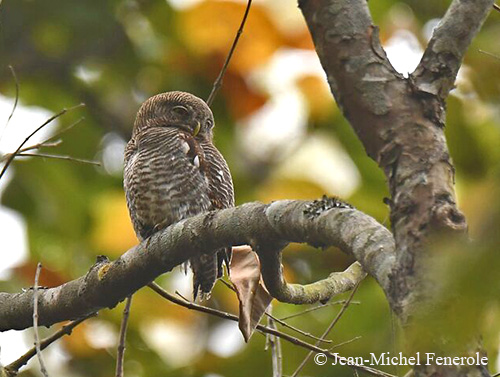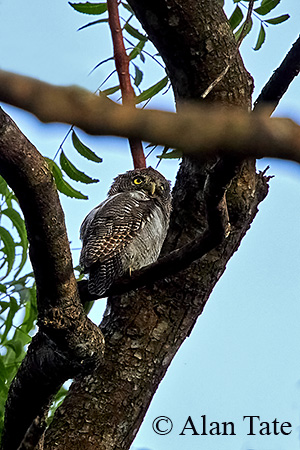
Fr: Chevêchette de jungle
Ang: Jungle Owlet
All: Dschungelzwergkauz
Esp: Mochuelo de Jungla
Ita: Civettina della giungla
Nd: Jungledwerguil
Sd: indisk sparvuggla
Photographers:
John Anderson
John Anderson Photo Galleries
Jean Michel Fenerole
Photos d’Oiseaux du monde
Alan & Ann Tate
AA Bird Photography
Text by Nicole Bouglouan
Sources:
HANDBOOK OF THE BIRDS OF THE WORLD Vol 5 by Josep del Hoyo-Andrew Elliott-Jordi Sargatal - Lynx Edicions - ISBN: 8487334253
A Field Guide to the Birds of South-East Asia by Craig Robson. New Holland Publishers. ISBN: 9781780090498
OWLS OF THE WORLD – By Claus König, Friedhelm Weick and Jan-Hendrik Becking - IBSN 978-0-7136-6548-2
Owls of the World: A Photographic Guide De Heimo Mikkola – Editeur: A&C Black, 2013 – ISBN: 1472905938, 9781472905932 – 528 pages
Jungle Safari - Jungle Owlet in Rajaji National Park
Wikipedia, the free encyclopaedia
Jungle Owlet
Glaucidium radiatum
Strigiformes Order - Strigidae Family
INTRODUCTION:
The Jungle Owlet is found in the Indian Subcontinent. Two subspecies share the range.
It frequents mixed deciduous forests and secondary growths, up to 1,200 metres of elevation, sometimes higher in some parts of the Himalayas.
It feeds primarily on a wide variety of insects, but lizards, rodents and small birds are also part of the diet. It is mainly active at dawn and dusk.
Like most Strigidae species, it typically roosts and nests in natural cavities in trees. Both parents share the nesting duties.
The Jungle Owlet is threatened by habitat loss and human disturbance. Conservation efforts are in progress to protect the future of this enigmatic species.
The Jungle Owlet is not globally threatened at the moment.

DESCRIPTION OF THE BIRD:
Biometrics:
Length: 20-22 cm
Weight: 88-114 g
The Jungle Owlet is a small, compact bird that blends perfectly into the habitat, thanks to its brown and white speckled plumage.
The adult has dark brown barred with white upperparts, but the upperwing is more rufous. The wing-coverts show white and rufous patches. Primaries and secondaries are dark brown, with pale chestnut bars.
The sooty black tail is narrowly barred with white.
The underparts are white with dark olive-brown barring. On the underwing, a rufous patch is conspicuous in flight. We can see a white area on chin, upper breast and centre of belly.
The rounded head (without ear tufts) is like the upperparts. The facial disk is barred brown and whitish. Eyebrows, chin and moustachial streak are white. This species lacks the “false eyes”.
The bill is greenish-yellow/yellowish-grey with bluish cere.
The large, piercing eyes are bright yellow. They are adapted to the low light of the jungle habitat.
Tarsi and feet are greenish-yellow with black claws. The strong talons help the bird to grasp and hold the prey. The feet are covered in small, bristly feathers providing an additional grip and support on perches and while hunting.
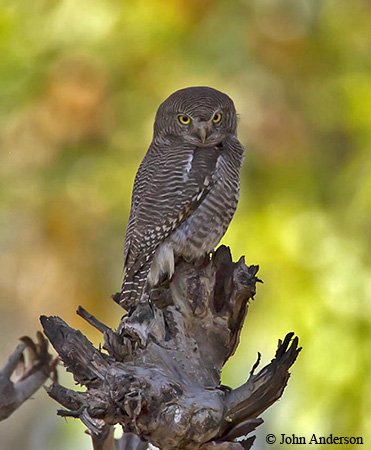
Male and female have similar appearance.
The juvenile has less distinct barring below and browner bars on the tail.
SUBSPECIES AND RANGE:
The Jungle Owlet has two subspecies.
G.r. radiatum (described above) occurs in the Himalayas to Bhutan, India, W Myanmar and Sri Lanka.
G.r. malabaricum is found in SW India.
This race is much darker than nominate, and more rufous overall. The tail is shorter and the head shows more brown.
HABITAT:
The Jungle Owlet frequents various types of forested habitats with thick undergrowth including deciduous and evergreen forests, and secondary growths. It is usually observed in wooded areas or plantations, but also in semi-urban areas with trees.
This species is found from the lowland plains to the hilly regions at different elevations, from 915 metres in Nepal, and up to 2,000 metres in the rest of the range.
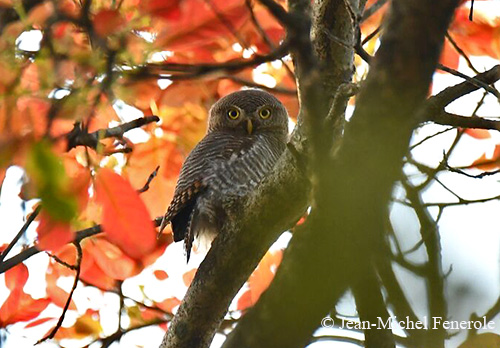
CALLS AND SONGS: SOUNDS BY XENO-CANTO
The Jungle Owlet is mainly heard at dawn and dusk, when it is very active, although calls can also be heard during the daytime.
The call is a rapid, loud, musical trill, a series of “prao” sounds increasing and then fading in volume, before ending rapidly “prao-prao-prao-prao-prao-prao”. This call is given for up to 15 minutes. A single phrase has 3 to 10 notes repeated at intervals of several seconds. We can also hear pleasant bubbling sounds.
During the day, the nestlings utter “tick” calls.
BEHAVIOUR IN THE WILD:
The Jungle Owlet is a small Strigidae but a fierce hunter. It is a carnivorous species, feeding primarily on insects, but small mammals, reptiles and small birds are also taken.
The insect diet includes beetles, grasshoppers and crickets, and also caterpillars, spiders and scorpions.
The Jungle Owlet hunts from perches, branch or tree trunk, scanning the surrounding area and waiting for a passing prey. When a potential prey is detected, it swoops down and catches it with the sharp talons.
It is a solitary species, usually most active at dawn and dusk and during the night. This owl has excellent vision and hearing, allowing it to forage and locate prey in the darkness.
During the day, the Jungle Owlet rests in the dense foliage or holes in trees. When roosting, it may be mobbed by other bird species such as drongos, treepies and sunbirds. If disturbed, it remains motionless and frozen while blending in with the habitat, often similar to a dead tree stump.
The Jungle Owlet is monogamous. During the breeding season, courtship displays accompanied by vocalizations are observed. The species is highly territorial and defends strongly the nesting site from intruders.
Both adults build the nest in tree hollow or abandoned woodpecker hole in tree. The parents share the nesting duties and continue to care for and protect the young from predators until they become independent.
The Jungle Owlet is resident of the dense forests of India, Nepal, Sri Lanka and Bhutan.
The flight is swift and direct, sometimes compared to the flight of a small hawk.
Both short tail and broad wings allow an agile flight through the dense forest canopy. Like most Strigidae species, the flight of the Jungle Owlet is silent.
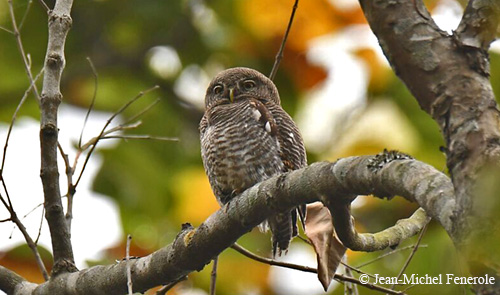
REPRODUCTION OF THIS SPECIES:
The breeding season takes place in March/June in Nepal, and from February-March to May in India.
The Jungle Owlet nests in natural cavities, a hollow in tree or an abandoned woodpecker hole. Both mates build the nest inside the cavity with twigs, leaves and grass. It is lined with softer materials including feathers. The nest is usually 3-5 metres above the ground.
The female lays 2-4 white eggs. Both adults share the incubation during 20-23 days. At hatching, the chicks have a covering of downy feathers. They are entirely dependent on their parents for food and care. They are fed on insects and small prey by regurgitation. They are protected and kept warm in the nest.
When the young grow older, they become more active and venture outside the cavity, hopping and fluttering their wings close to their parents.
They fledge a month after hatching and leave the nest, but they are still fed for several weeks by the adults, until they become fully independent.
PROTECTION / THREATS / STATUS:
The Jungle Owlet is affected by loss and degradation of the habitat. In Sri Lanka, the deforestation is an important threat. Poaching and human disturbance also have a negative impact.
Conservation efforts are in progress, through habitat restoration, community engagement and scientific research, to protect the future of this species.
The size of the population is unknown, but it is suspected to be stable at the moment.
The Jungle Owlet is currently evaluated as Least Concern.
